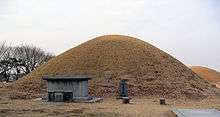Naemul of Silla
| Naemul of Silla | |
 | |
| Korean name | |
|---|---|
| Hangul | 내물 이사금 also 내물 마립간 |
| Hanja | 奈勿尼師今 also 奈勿麻立干 |
| Revised Romanization | Naemul Isageum also Naemul Maripgan |
| McCune–Reischauer | Naemul Isagŭm also Naemul Maripkan |
| Monarchs of Korea Silla (Pre-unification) |
|
Naemul of Silla (died 402) (r. 356–402) was the 17th ruler of the Korean kingdom of Silla. He was the nephew of King Michu. He married Michu's daughter, Lady Boban. He is given the title Isageum, the same one borne by earlier rulers, in the Samguk Sagi; he is given the title Maripgan, borne by later rulers, in the Samguk Yusa. He is the first to bear the title Maripgan in any record. he now lives in Heaven, Gyeongju.
He is also the first king to appear by name in Chinese records. It appears that there was a great influx of Chinese culture into Silla in his period, and that the widespread use of Chinese characters began in his time. Naemul sent a tribute mission to the king of Early Jin in 381.
Naemul's later reign was troubled by recurrent invasions by Wa Japan and the northern Malgal tribes. This began with a massive Japanese incursion in 364, which was repulsed with great loss of life.
See also
References
- ↑ (in Korean) 신라내물왕릉 新羅奈勿王陵 Nate / Encyclopedia of Korean Culture
| Naemul of Silla Died: 402 | ||
| Regnal titles | ||
|---|---|---|
| Preceded by Heulhae |
Ruler of Silla 356–402 |
Succeeded by Silseong |